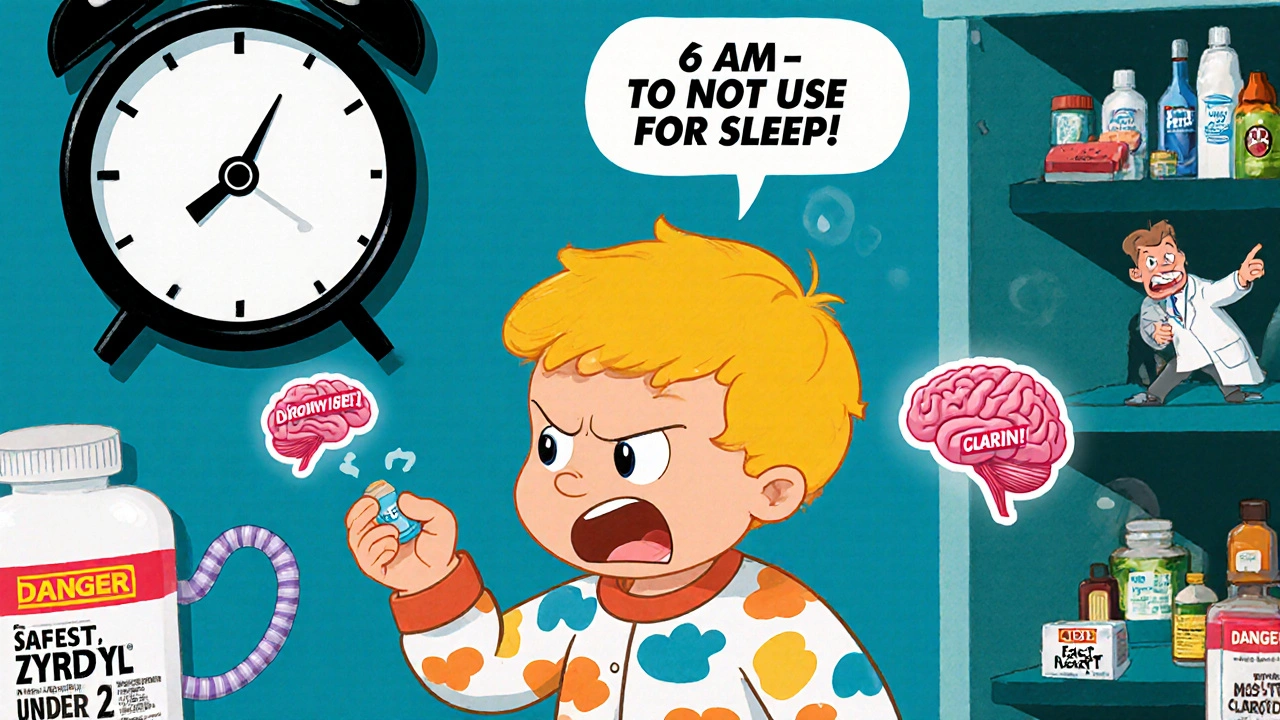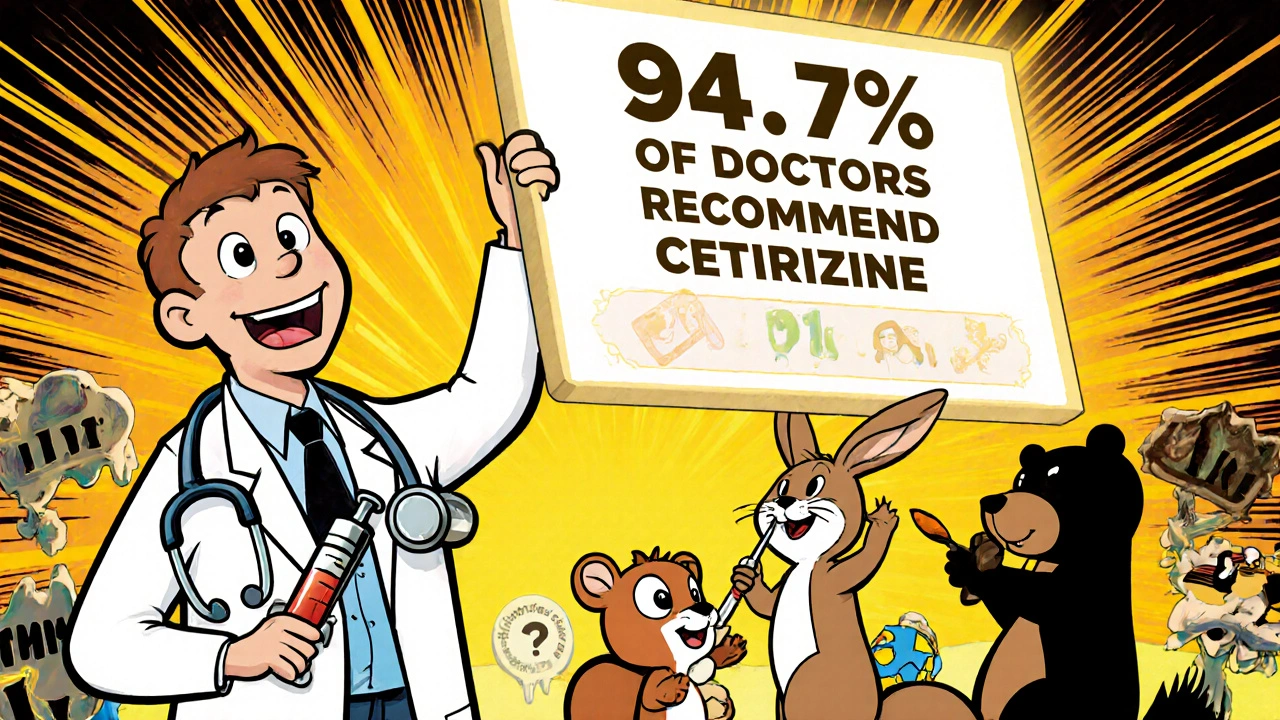Antihistamine Dosing Calculator
Calculate Safe Doses
Recommended Dose
Every parent has been there: your child wakes up with red, itchy bumps all over their arms, or their eyes swell shut after playing outside. You reach for the medicine cabinet and pull out that bottle of Benadryl-it worked for you as a kid, right? But here’s the hard truth: what’s safe for adults isn’t always safe for children. Antihistamines can help with allergies, hives, or bug bites, but giving the wrong dose or the wrong type can put your child at risk. The good news? There are safer, smarter choices-and knowing them could make all the difference.
Not All Antihistamines Are Created Equal
There are two main types of antihistamines: first-generation and second-generation. The difference isn’t just in the name-it’s in how they affect your child’s body.First-generation antihistamines like diphenhydramine (Benadryl) cross the blood-brain barrier easily. That’s why they make adults drowsy. In young children, that same effect can turn dangerous. Studies show up to 60% of kids given diphenhydramine become extremely sleepy, confused, or even agitated. Some experience dry mouth, fast heartbeat, or trouble urinating. In rare cases, especially under age 2, it can slow breathing to dangerous levels. That’s why the FDA has warned against using Benadryl in children under 2 without a doctor’s order.
Second-generation antihistamines like cetirizine (Zyrtec) and loratadine (Claritin) were designed to stay out of the brain. They work just as well for allergies but cause drowsiness in only 10-15% of children-compared to 50-60% with diphenhydramine. Cetirizine is slightly more likely to cause sleepiness than loratadine, but both are far safer than older options. For chronic allergies, eczema flare-ups, or recurring hives, these are the clear first choices.
What Age Is Safe? The Rules by Drug
You can’t just guess the right dose based on your child’s age. Each medication has strict approval limits-and many are used off-label in younger kids under medical supervision.- Cetirizine (Zyrtec): FDA-approved for children 6 months and older. For infants 6-11 months, doctors often start with 0.125 mg per kilogram of body weight per day, then increase to 0.25 mg/kg if needed. For kids 2-5 years, the standard dose is 5 mg once daily (1 teaspoon of liquid). Kids 6-11 years can take 5-10 mg daily. Children 12 and older take 10 mg daily.
- Loratadine (Claritin): Approved for children 2 years and older. Dose: 2.5 mg daily (½ teaspoon of liquid) for ages 2-5. For ages 6-11, use 5 mg daily (1 teaspoon). Kids 12+ take 10 mg daily.
- Diphenhydramine (Benadryl): Not approved for routine use under age 2. Even for older children, it should only be used for acute reactions like sudden hives or insect bites-and only under a doctor’s guidance. Never use it as a sleep aid.
Many parents don’t realize that chewable tablets come in different strengths. Some are 5 mg, others are 10 mg. Always check the label. Giving a 10 mg tablet to a 3-year-old by mistake is a common-and dangerous-error.
Dosing by Weight, Not Just Age
Age is a starting point, but weight is what matters most-especially for infants and toddlers. A 15-pound baby needs a very different dose than a 35-pound toddler, even if they’re both 18 months old.For cetirizine in infants 6-11 months, the dose is calculated as 0.25 mg per kilogram of body weight, divided into one daily dose. For example, an 8 kg (17.6 lb) baby would get about 2 mg total per day. Since liquid Zyrtec is 1 mg per mL, that’s 2 mL once a day. This is off-label use, meaning it’s not officially FDA-approved for this age group-but it’s supported by clinical studies and recommended by pediatric allergists like Dr. Eric Macy.
For diphenhydramine, if prescribed for an older child, dosing is strictly weight-based:
- 22-37 lbs: 5 mL (12.5 mg) every 4-6 hours
- 38-49 lbs: 7.5 mL (18.75 mg) every 4-6 hours
- 50-99 lbs: 10 mL (25 mg) every 4-6 hours
Never give more than 6 doses in 24 hours. And don’t use adult tablets or liquid for kids. The concentration is different. What looks like a small sip from a kitchen spoon could be a dangerous overdose.

Measurement Matters More Than You Think
One of the biggest mistakes parents make? Using a kitchen spoon.A standard teaspoon holds about 5 mL-but most kitchen spoons vary by 20-50%. That means you could be giving your child 3 mL instead of 5 mL… or 7.5 mL instead of 5 mL. Either way, it’s wrong.
Every bottle of liquid antihistamine comes with a measuring device: a syringe, cup, or dropper. Always use that. Never guess. Even if the bottle says “1 teaspoon,” use the tool that came with it. Boston Children’s Hospital, Children’s Hospital Colorado, and St. Louis Children’s Hospital all stress this point. It’s not a suggestion-it’s a safety rule.
Also, never mix antihistamines with decongestants. Products like “Children’s Claritin-D” or “Benadryl Allergy Plus Congestion” contain pseudoephedrine or phenylephrine. These are not safe for children under 6. The FDA says they can raise blood pressure, cause rapid heartbeat, or trigger seizures in young kids. Stick to plain antihistamines unless your doctor says otherwise.
When to Avoid Antihistamines Altogether
Some situations call for a doctor, not a medicine cabinet.- Under 2 years old: Avoid all antihistamines unless prescribed. Even second-generation ones like cetirizine should only be given under medical supervision for babies under 6 months.
- For sleep: Using antihistamines to make a child sleepy is dangerous and ineffective. Studies show this practice increases overdose risk by 300% in children under 2. It doesn’t improve sleep quality-it just masks symptoms and masks danger.
- With other medications: If your child takes seizure meds, antidepressants, or asthma inhalers, antihistamines can interact. Always check with your pediatrician.
- Signs of overdose: Extreme drowsiness, dilated pupils, blurry vision, racing heart, dry mouth, trouble urinating, or agitation? Call Poison Control immediately at 1-800-222-1222. Don’t wait.
And remember: antihistamines treat symptoms, not the cause. If your child has recurring allergies, it’s time to see an allergist. They can help identify triggers and recommend long-term solutions like allergy shots or environmental changes.

What Experts Are Saying Now
The latest guidelines from the American Academy of Allergy, Asthma & Immunology (AAAAI) are clear: second-generation antihistamines are the new standard for kids. Dr. Eric Macy, a leading pediatric allergist, says: “Given that cetirizine 0.25 mg/kg/day has been shown to be safe and effective in infants 6 to 11 months old, I would recommend starting at 0.125 mg/kg/day and increasing if needed.”That’s not just an opinion-it’s backed by research. A 2020 study in Pediatric Allergy and Immunology found cetirizine was well-tolerated in infants as young as 6 months, with no serious side effects. Meanwhile, the use of diphenhydramine in children under 2 has dropped by nearly 40% since 2018, thanks to better education and updated hospital protocols.
Major children’s hospitals in the U.S. now have standardized dosing charts that prioritize cetirizine. In 2023, 94.7% of pediatric allergists surveyed by AAAAI said they recommend second-generation antihistamines as first-line treatment. That’s not a trend-it’s the new normal.
What’s Coming Next
Research is still evolving. The FDA is requiring more safety data for antihistamines in children under 2, with results expected by 2025. Clinical trials are underway to potentially approve cetirizine for infants under 6 months by 2026. Until then, doctors will continue using it off-label in babies with severe allergies-but only with careful monitoring.For now, the message is simple: when in doubt, skip the old-school antihistamines. Choose cetirizine or loratadine. Measure precisely. Avoid decongestants. And never, ever use them to help your child sleep.
If you’re unsure what to give your child, call your pediatrician. Better yet, ask for a referral to a pediatric allergist. Allergies don’t have to be managed with guesswork-and they shouldn’t be.
Can I give my 4-month-old baby Zyrtec for hives?
Zyrtec (cetirizine) is FDA-approved for children 6 months and older. For babies under 6 months, it’s considered off-label use and should only be given under a doctor’s supervision. If your 4-month-old has hives, contact your pediatrician. They may recommend a very low dose-around 0.125 mg per kilogram of body weight-but never give it without medical advice.
Is Benadryl safe for toddlers?
Benadryl (diphenhydramine) is not recommended for routine use in toddlers under 2 years. Even for older toddlers, it should only be used for sudden allergic reactions like hives or insect bites-and never as a sleep aid. It can cause dangerous drowsiness, confusion, or breathing problems. Cetirizine or loratadine are safer alternatives for ongoing allergy symptoms.
How do I measure liquid antihistamine correctly?
Always use the measuring device that came with the bottle-whether it’s a syringe, cup, or dropper. Never use a kitchen teaspoon, as it can be off by 20-50%. For example, if the dose is 5 mL, fill the syringe to the 5 mL mark. Even a small error can lead to underdosing or overdose. Store the device with the bottle so you don’t lose it.
Can I give my child Claritin and Zyrtec together?
No. Both are antihistamines and work the same way. Giving them together doesn’t make them stronger-it increases the risk of side effects like drowsiness or dry mouth. Pick one and stick with it. If one isn’t working, talk to your doctor before switching or adding another medication.
What should I do if I think my child overdosed on antihistamine?
Call Poison Control immediately at 1-800-222-1222. Signs of overdose include extreme sleepiness, confusion, fast heartbeat, dilated pupils, dry mouth, trouble urinating, or agitation. Do not wait for symptoms to worsen. Do not try to make your child vomit. Keep the medicine bottle handy when you call so you can tell them the exact name and amount given.





Alyssa Torres
November 20, 2025 AT 02:39Okay but real talk-how many of us have reached for Benadryl without thinking twice? I did it last summer when my kid broke out in hives after a picnic. Panicked, grabbed the bottle, gave it to him… and he slept for 12 hours straight. Not the good kind. I felt like a terrible mom until I read this. Thank you for spelling out the risks so clearly. I’m switching to Zyrtec now. No more guessing.
Also-PLEASE stop using kitchen spoons. I used to. Now I keep the syringe taped to the fridge. It’s weird but it saves lives.
Summer Joy
November 21, 2025 AT 10:51OMG I KNEW IT 😭 Benadryl is basically a sedative for kids and nobody tells you that!! My cousin’s toddler got hospitalized last year because her grandma gave her ‘a little bit’ for a rash. Like… what even IS a little bit?? 😵💫 The system is broken. Why is this not on every pediatrician’s wall??
Aruna Urban Planner
November 21, 2025 AT 12:08The pharmacokinetic profile of first-generation antihistamines in developing CNS tissue remains underappreciated in primary care settings. The blood-brain barrier permeability of diphenhydramine is dose-dependent and non-linear in pediatric populations under 24 months, which explains the biphasic response patterns-initial CNS depression followed by paradoxical agitation.
Second-generation agents exhibit significantly reduced affinity for H1 receptors in the hypothalamus, thereby minimizing sedative side effects. The 0.25 mg/kg dosing protocol for cetirizine in infants is supported by phase II trials from the Pediatric Allergy Research Consortium (2020), though off-label use requires careful titration.
Parental education must shift from age-based to weight-based dosing algorithms. Standardized weight bands in dispensing systems could reduce dosing errors by up to 78% according to a 2022 JAMA Pediatrics meta-analysis.
Nicole Ziegler
November 23, 2025 AT 11:20Measuring with the syringe = non-negotiable 🙌 I lost my kid’s syringe once and used a teaspoon… he was super sleepy for 3 hours. I felt like a monster. Now I have a little labeled box with all the meds and their tools. No more guessing. Also, Zyrtec for my 18mo? Lifesaver. No more midnight wake-ups from hives. 🤍
Bharat Alasandi
November 23, 2025 AT 17:13Bro this is gold. I’m from India and we just give kids whatever’s lying around. My niece got Benadryl for a mosquito bite last year-she was wild for hours. Then cried all night. I didn’t know it could do that. Now I keep Zyrtec liquid at home. No more panic buying at 2am.
Also-don’t mix with decongestants. I saw a mom give her 3yo Claritin-D because she thought ‘more medicine = better’. Bro, that’s a recipe for a trip to the ER.
Shiv Karan Singh
November 24, 2025 AT 01:57So you’re telling me the FDA is actually doing something right? 🤨
Let me guess-Big Pharma pushed second-gen antihistamines because they’re more expensive and patented. Benadryl’s been around for 70 years and worked fine for my whole family. You think your ‘studies’ are better than real-life experience? My cousin’s kid took Benadryl every year for allergies and grew up to be a track star. Coincidence? I think not.
Also, why are hospitals pushing this? Because they get paid more for follow-ups when kids overdose on ‘safe’ meds? Just saying.
Ravi boy
November 24, 2025 AT 18:04yea i always used benadryl for my son he was 2 and it worked fine no issues
now i read this and im like maybe i was lucky
but why do they say its dangerous if so many kids took it and turned out ok
also the syringe thing i lost mine twice and just used a spoon
no one ever told me it was a big deal
Matthew Karrs
November 25, 2025 AT 11:40Let’s be real-this whole thing is a controlled narrative. Why is Benadryl suddenly dangerous? Because they want you to buy the expensive stuff. The FDA? They’re owned by pharma. The ‘studies’? Sponsored by Zyrtec’s parent company.
I’ve seen doctors push these meds because they get kickbacks. My cousin works in a hospital pharmacy-she told me they get bonuses for prescribing second-gen. And don’t get me started on the ‘off-label’ excuse. That’s just a loophole to sell more drugs.
My kid took Benadryl since he was 11 months. He’s 7 now. Healthy. Smart. Doesn’t sleep like a zombie. So don’t tell me this is science. It’s profit.
Matthew Peters
November 27, 2025 AT 09:09I’m a dad of three. I used Benadryl for my oldest-she got super drowsy, then hyper, then threw up. I thought it was just ‘her personality’. Then my second kid got the same reaction. I thought, okay, maybe she’s sensitive. Then my third-same thing. I didn’t connect the dots until I read this.
Switched to Zyrtec. Zero issues. No drowsiness. No weird behavior. Just calm relief. I feel like an idiot for waiting so long. Why didn’t anyone just tell me this? Why is this not in every pediatric waiting room?
Also-yes, the syringe. I have one labeled ‘Zyrtec Only’ hanging on my fridge now. I’m not taking chances anymore.
Liam Strachan
November 29, 2025 AT 04:07Interesting read. I’m from the UK and we’re quite cautious here with OTC meds for kids. We’re taught from day one to check the label, use the measuring tool, and avoid first-gen unless it’s an emergency. Still, it’s easy to slip into old habits when you’re tired and your child is miserable.
It’s reassuring to see the data backing up what we’ve been told. And I appreciate the emphasis on allergist referrals-too many parents treat symptoms without addressing root causes. Allergies aren’t just ‘a rash’-they’re a signal.
Gerald Cheruiyot
November 30, 2025 AT 19:55There’s a deeper truth here that no one talks about
We treat children like small adults with the same biology and same tolerance
But their bodies aren’t just mini versions
They’re developing systems with different metabolism rates different receptor sensitivities different blood brain barrier integrity
That’s why age and weight matter
That’s why we need to stop thinking in terms of ‘what worked for me’
And start thinking in terms of what’s safe for this child right now
Not the child we were
Not the child our parents raised
But this one
Right here
Today
Michael Fessler
December 1, 2025 AT 16:05As a nurse who’s seen too many kids come in with antihistamine toxicity, this needs to be everywhere. I had a 14-month-old last month who got 10mg of diphenhydramine because his mom thought ‘it’s just one pill’-but it was the 10mg chewable. He had seizures. He’s fine now, but it took 12 hours in the ER.
Also-parents, the measuring cup that comes with the bottle? It’s calibrated to the exact concentration. Kitchen spoons? Not even close. I’ve seen doses vary by 50% just from using a spoon.
And yes-NO decongestants under 6. I’ve seen kids on Claritin-D with heart rates over 180. It’s not a ‘little extra help’. It’s a medical emergency waiting to happen.
daniel lopez
December 1, 2025 AT 19:50So you’re saying the government and doctors are right and parents are dumb for trusting what worked for generations? Classic brainwashing. Benadryl has been used safely for decades. Now suddenly it’s a poison because some ‘experts’ say so? Where’s the proof? Where’s the long-term data? You’re scared of the word ‘off-label’ like it’s a curse word.
My kids took Benadryl since they were babies. No problems. Now they’re healthy teens. So I’m not switching. I’m not paying extra for a branded drug that does the same thing. And I’m not using a syringe because I’m not a lab technician. I’m a parent. I know my kid.
This isn’t science. It’s fearmongering dressed up as advice.